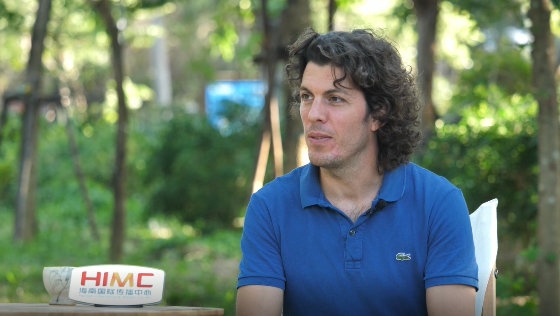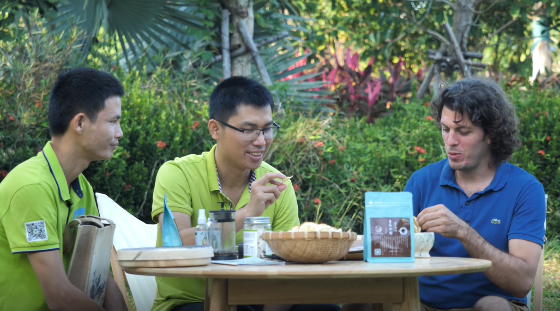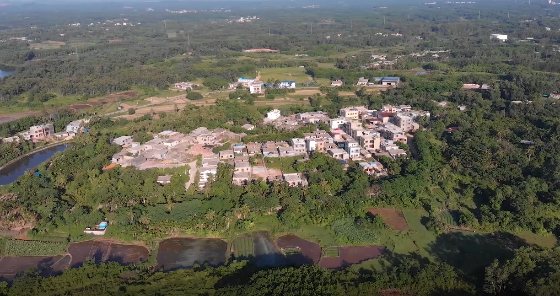Parisian Paul Iglesia’s first time to China was in 2008 as a short term student at Shanghai’s Tongji University. In a story common with many long term expats, his short visit was extended again and again, by 2021, he had already spent 13 years living and working in Shanghai “becoming a part of China’s breakneck pace from plans to construction to completion”. From software companies digital marketer to advertising agency employee to consultant, Paul has also experienced breakneck personal development during his time in China.
The first non-Chinese to actively take part in the Citan Village’s rural vitalization project spearheaded by local businessman HU Shize, Paul is both like the many foreigners who have seen themselves follow a trajectory from party hopping DJ to business consultancy and like the many Chinese who have turned their eyes from the razzle dazzle of metropolises like Shanghai for the quiet countryside of Hainan.

Paul Iglesia. HIMC
Citan Village, located in Hainan’s Ding’an County on the banks of the Longzhou River, is a model ecological village that has been recognized by the government as a “Provincial Health Village”, “Social Core Value Demonstration Base,” and model “Civilized Village”. Home to more than 700 villagers, it was—until recently—a fairly poor area . At the end of 2015, local businessman Hu Shize (who had originally left the village in 2002 to attend university before eventually relocating to Shanghai) made the decision to return to his roots and work to lift his village out of poverty. Owing to his experiences (both academically and professionally), Hu—as an entrepreneur with international vision—alongside his team were able to help implement China’s rural vitalization strategy and lead Citan to become a model of how villages can use locally grown agricultural products as a path to prosperity.
In the six years since Hu started working, twenty some odd foreigners from a dozen countries have come to Citan on business, with Paul being the first to actively join the project.

Paul, Hu Shize and Luo Zhenhua. HIMC
Staying only a few days in Hainan on his first visit in summer the “tropical scenery, beautiful natural environment, fresh fruit and tasty seafood” all gave him a deep impression reminiscent of coastal vacation areas in places like Africa and Mexico. Hearing about Hu and Citan Village through a mutual friend after his return to Shanghai, Paul checked them out on the internet and exchanged messages with Hu before deciding that his desire to explore more of the island’s inland regions were as good an excuse as any to escape Shanghai’s winter and Shanghai’s rat race. Consequently, Paul and his girlfriend made the decision to relocate, and—along with their dog—moved to Hainan. In November 2021, only a short while after they moved, they set out to visit Citan Village.
They loved their three-day visit to Citan. From common tropical agricultural products such as coffee, pineapple and natural rubber to more exotic ones like tiger milk mushrooms and areca palms, the idea of using unique agricultural products to lift a village up from poverty drew Paul’s interest. Looking deeper, he found that the local government’s supportive policies meant that Citan was a fertile field ready for development. If all goes according to plan, Paul Iglesia and HU Shize will formally sign a contract early in January 2022 for Paul to work as the Urban-Rural Bridge (URB) representative for Citan as a URB model eco-village. “Right now we are building a website and launching a WeChat miniprogram for promoting Citan’s agricultural products. We are also getting ready on a number of other online platforms within China and enriching our international contacts in preparation for information exchange in terms of agricultural knowledge, production and marketing experience. On top of these, we are working to expand the training class project that Hu has been working on towards eventually becoming a training institute.” Above all, the goal that Paul has is to use Citan village as an “example” which can show how good village life can be when there is appropriate development.

Citan Village. HIMC
When it comes to the positive changes which have resulted from China’s rural vitalization strategy, Paul says that it not only serves to improve local people’s lives but also encourages young people from the villages (especially those who have been educated in universities far from home) to come back home and put their knowledge to practice helping their hometowns. Paul also expressed his positive opinion of the trend where a growing number of young, skilled and well educated talents are deciding to “go down to the countryside” instead of staying in cities. “When it comes to rural vitalization projects like Citan we need engineers and agricultural technicians or sometimes even scientists to make it happen.”
As an expat, Paul feels that foreigners can act as bridges between people with different cultural backgrounds and that, as bridges, they can help push rural vitalization forward. The goal of exchange between cultures is more than just empty buzzwords. Sometimes even just having new and different recipes for the same kind of vegetable can be valuable. Also, the construction of Hainan as a Free Trade Port is promising for the future development of the island and Paul is thrilled to be a part of this great wave of development.






















